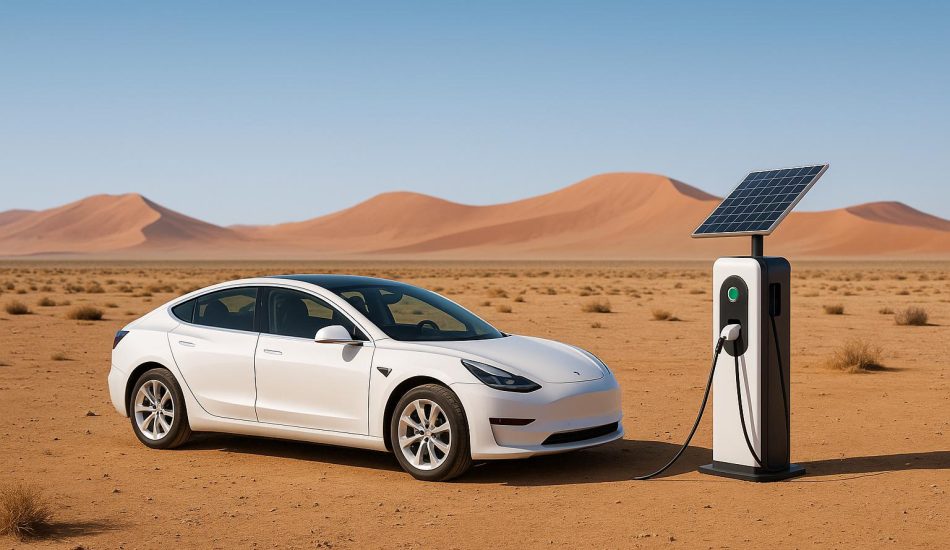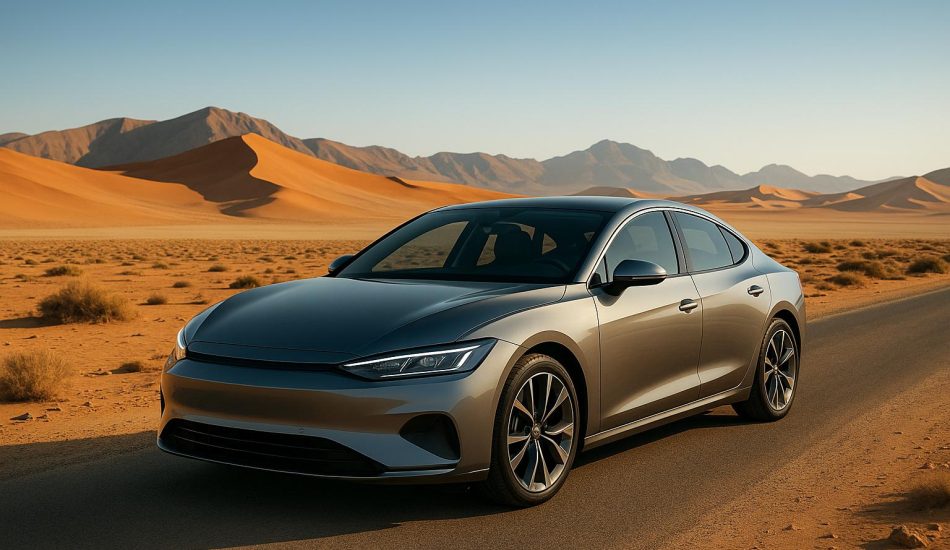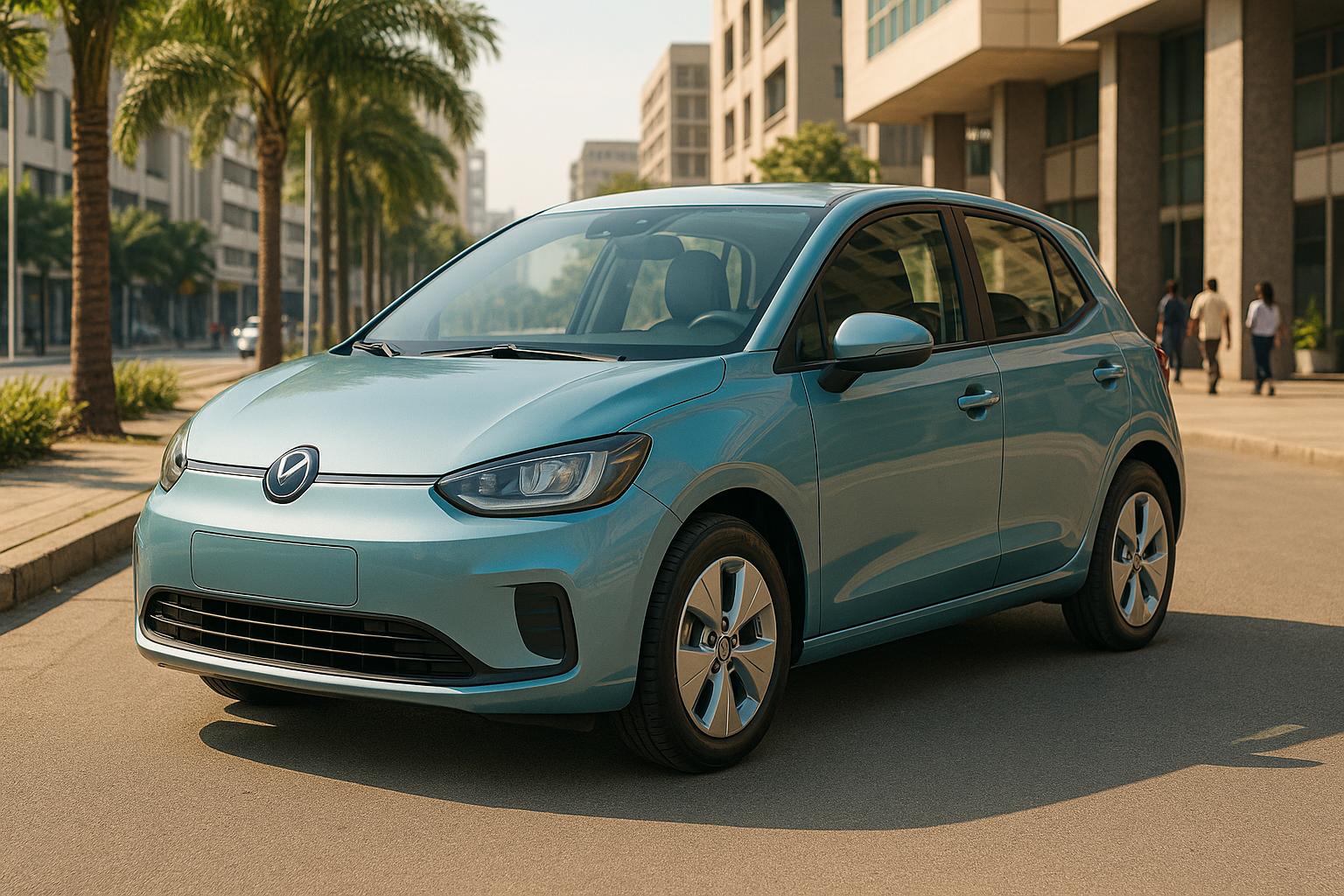
Electric cars are becoming more accessible in the Democratic Republic of Congo (DRC), offering new options for affordable and sustainable transportation. Here are the top picks for 2025:
- BYD Dolphin: $25,000–$35,000, 420–520 km range, fast charging in 29–38 minutes.
- Geely Geometry C: $21,000–$25,500, 342 miles range, fast charging in 17 minutes.
- Leapmotor T03: $8,000–$12,000, 165–345 km range, compact and budget-friendly.
- Dongfeng EV EX1: $8,700, 331 km range, versatile and reliable.
- Suzuki Swift (Hybrid): $24,490, not fully electric but offers improved fuel efficiency.
Quick Comparison
| Model | Price (USD) | Range (Miles) | Battery Type | Charging Time | Best For |
|---|---|---|---|---|---|
| BYD Dolphin | $25,000–$35,000 | 261–323 | Lithium Iron Phosphate (LFP) | 29–38 minutes (fast) | City driving, long lifespan |
| Geely Geometry C | $21,000–$25,500 | 217–342 | Lithium Iron Phosphate (LFP) | 17 minutes (fast) | Long trips, urban commutes |
| Leapmotor T03 | $8,000–$12,000 | 165–215 | Lithium Iron Phosphate (LFP) | 36 minutes (fast) | Budget buyers, city use |
| Dongfeng EV EX1 | $8,700 | 206 | Lithium Iron Phosphate (LFP) | 35–44 minutes (fast) | Affordable, rugged roads |
| Suzuki Swift (Hybrid) | $24,490 | N/A (Hybrid) | 10Ah Lithium-ion (Hybrid) | N/A | Familiar brand, fuel efficiency |
Key Takeaway: For budget-conscious buyers, the Leapmotor T03 and Dongfeng EV EX1 are excellent choices. For longer range, the Geely Geometry C and BYD Dolphin stand out. However, charging infrastructure and road conditions in the DRC remain key challenges for EV adoption.
Chinese EVs You Can Buy in Kenya – Africa EV Show
What to Consider When Buying Electric Cars in the DRC
Buying an electric vehicle (EV) in the Democratic Republic of Congo (DRC) involves more than just comparing it to traditional cars. The local infrastructure, economic conditions, and unique challenges of the region all play a role in the decision-making process.
Purchase Price and Total Cost of Ownership
One of the biggest barriers to EV adoption is the upfront cost. On average, EVs are about 30% more expensive than traditional vehicles, with some cases showing price differences as high as 70%. For context, the average price of a new EV is around $55,600. However, it’s not just about the sticker price. Potential buyers need to consider the total cost of ownership, which includes savings on fuel, lower maintenance costs, and the price of electricity. These factors are especially important in a market where purchasing power is limited.
Government Incentives and Import Policies
Government policies can make a huge difference in EV affordability. In the DRC, high import taxes can significantly impact the price of electric vehicles. While some sub-Saharan African countries impose heavy duties on EVs, others are beginning to offer tax breaks or subsidies to encourage adoption. For buyers, it’s worth researching current government incentives, as they can substantially lower the effective purchase price.
Charging Infrastructure Challenges
A major consideration for EV buyers in the DRC is the lack of widespread charging infrastructure. With limited access to electricity across much of the country, establishing a reliable charging network is a challenge. This means buyers often need to plan for home charging solutions or prioritize vehicles with extended driving ranges. While the DRC’s hydroelectric potential offers hope for future grid improvements, it’s important to have realistic expectations about current charging availability.
Road Conditions and Vehicle Durability
Road quality in the DRC is a significant factor. With less than 2% of roads paved, EV buyers should look for models equipped with durable suspensions and higher ground clearance to navigate rough terrain. In major cities like Kinshasa, traffic congestion – made worse by poor road infrastructure and occasional flooding – further emphasizes the need for vehicles with longer ranges.
Maintenance and Service Availability
Maintenance is another critical consideration. The region lacks a sufficient number of skilled EV technicians, and repair processes can be more complex compared to traditional vehicles. EV buyers should research the availability of service centers and prioritize models from manufacturers with an established presence in the region. Without reliable service options, keeping an EV operational in challenging terrains could become an issue.
Financing and Market Options
Affordability remains a key concern, with the second-hand vehicle market dominating in sub-Saharan Africa. However, the used EV market is still in its infancy. Buyers should explore specialized EV financing options, such as those offered by platforms like EV24.africa, which aim to make EVs more accessible.
Energy Sources and Sustainability
The DRC’s abundant hydroelectric and solar resources could help offset some infrastructure challenges. While the country has vast hydroelectric potential, much of its current grid energy is tied to fossil fuels, especially in mining operations. Buyers might consider solar charging solutions to reduce dependence on the grid and ensure a more sustainable way to operate their vehicles. Solar charging could be particularly beneficial given the DRC’s plentiful sunlight and the frequent unreliability of grid access.
Interestingly, survey data from South Africa shows that over 70% of respondents would consider switching to EVs if prices dropped below $30,000. This suggests that more affordable models could significantly increase EV adoption in the DRC, making budget-friendly options a crucial factor for the market’s growth.
1. BYD Dolphin
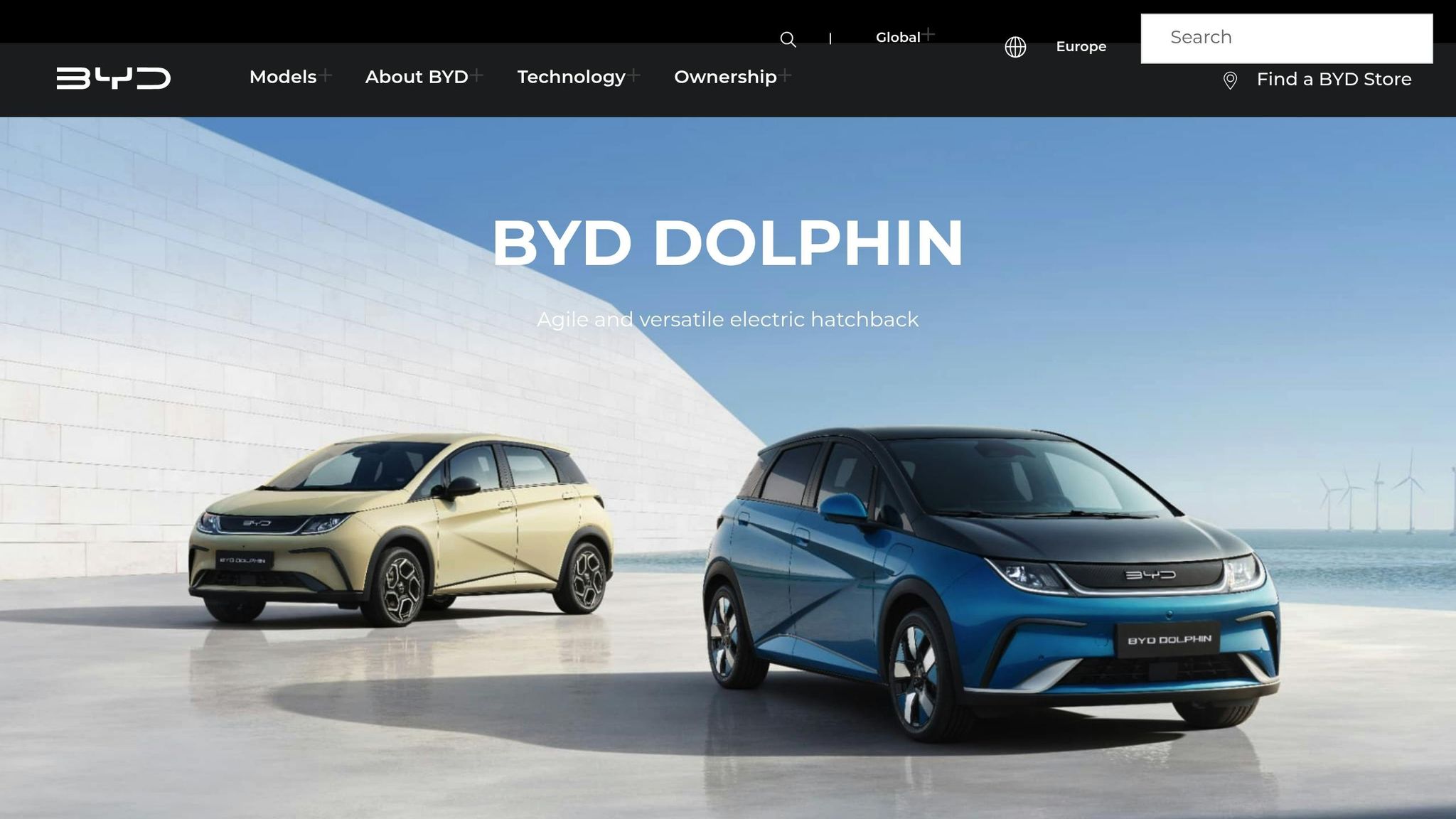
The BYD Dolphin stands out with its advanced Blade Battery technology and flexible range options, offered across four trims – Vitality, Free, Fashion, and Knight. It combines practicality and affordability, making it a strong contender in the DRC’s growing EV market. Let’s dive into the features that make this EV a smart choice.
Range (miles/kilometers)
When tested under CLTC standards, the Dolphin delivers impressive range figures. The Vitality, Free, and Fashion trims can reach about 420 km (261 mi), while the Knight trim stretches to approximately 520 km (323 mi). In real-world conditions, you can expect ranges between 150–220 miles. With the larger 60.4 kWh battery, the range varies from 245 km to 520 km, depending on driving habits and conditions.
Battery Type
The Dolphin is equipped with BYD’s Blade Battery, featuring lithium iron phosphate (LFP) chemistry. This battery is built to last, offering over 1 million kilometers (up to 3,000 charge cycles) and a lifespan four times longer than standard batteries. Plus, it comes with an impressive warranty of 20–25 years. The battery’s Cell-to-Pack (CTP) technology improves space efficiency by 50% and eliminates the need for cobalt, making it more sustainable. Safety is also a highlight – the Blade Battery passes nail penetration tests without catching fire.
Charging Time
Charging the Dolphin is straightforward and flexible. For AC charging, the 44.9 kWh version takes 19.7 hours with a 10-A socket or 6.4 hours with a 16-A wall charger. The 60.5 kWh version requires 26.5 hours or 9.6 hours, respectively. If you’re in a hurry, DC fast charging is your go-to. The 44.9 kWh battery charges from 10% to 80% in just 38 minutes, while the 60.5 kWh version does it in 35 minutes. Using a 100-kW DC charger, the Blade Battery can go from 30% to 80% in only 29 minutes. For home setups, a 1-phase 32-A (7.4 kW) charger gets the job done in about 9 hours and 45 minutes.
Price (US Dollars)
The BYD Dolphin is expected to be priced between $25,000 and $35,000, though final costs will depend on import duties and local taxes. Its affordability is further enhanced by lower fuel costs, reduced maintenance needs, and the long lifespan of its battery. With over 70% of prospective EV buyers preferring options under $30,000, and potential government incentives in play, the Dolphin offers significant value for money.
2. Geely Geometry C
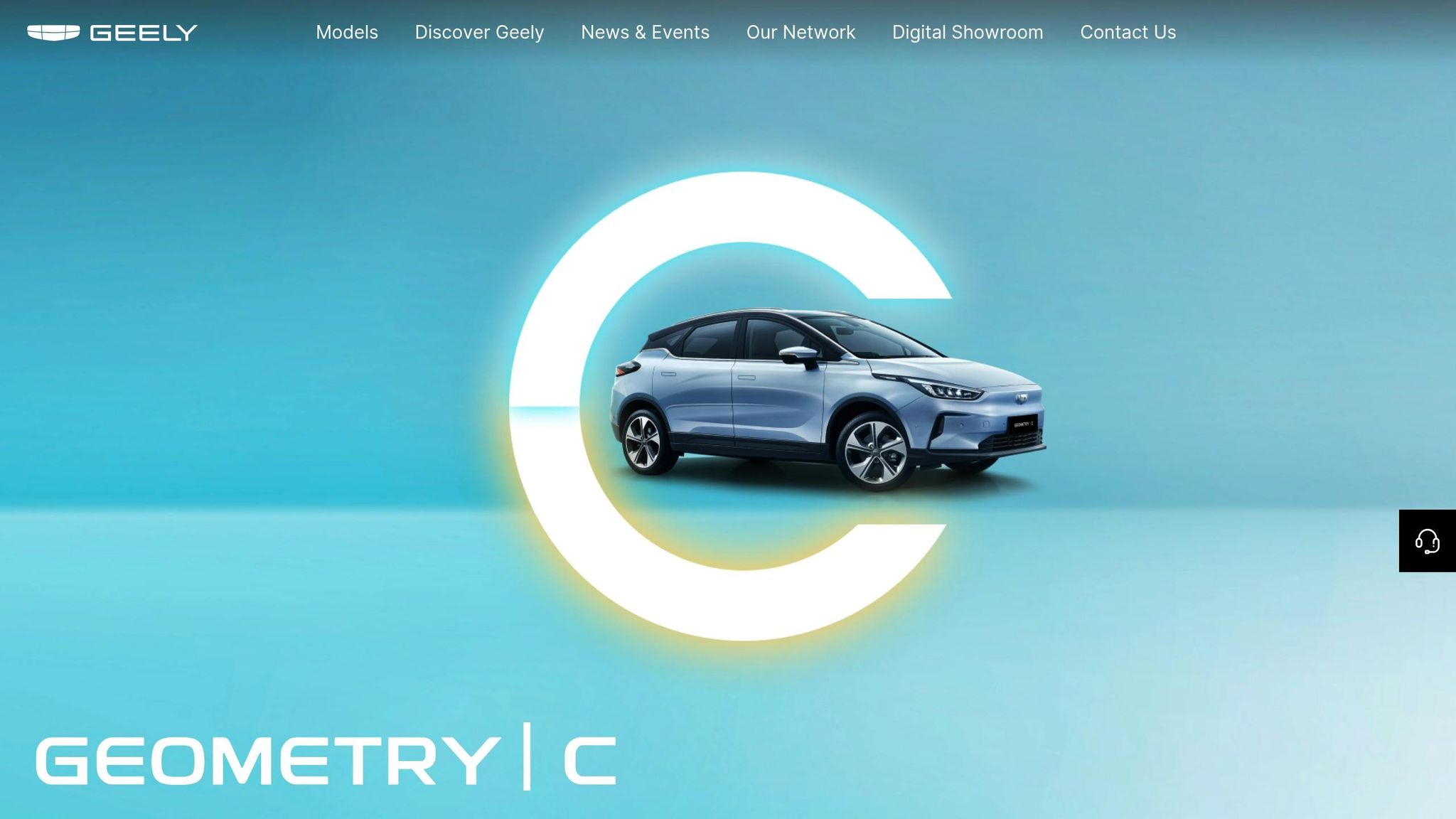
After the BYD Dolphin, the Geely Geometry C stands out as another strong contender in the affordable EV market in the DRC. Designed with urban commuters in mind, this electric SUV combines modern style and efficiency. With two battery options available, it caters to a range of driving needs and budgets, making it a practical choice for both families and professionals.
Range (miles/kilometers)
The Geometry C offers impressive range capabilities, depending on the battery configuration:
- 550 kilometers (342 miles) per charge with the larger battery pack.
- 217 miles (WLTP-tested) with the 53 kWh version, ideal for those seeking a more economical option.
- 460 kilometers (286 miles) with the 70 kWh battery pack.
These options make the Geometry C suitable for daily city commutes and occasional longer trips between cities.
Battery Type
The Geometry C is powered by a lithium iron phosphate (LFP) battery, a type known for its durability and safety. Geely uses advanced "short blade" LFP technology that boasts a lifespan of up to 1 million kilometers.
This battery design incorporates multi-element doped electrode materials, which help slow down internal chemical reactions, enhancing its longevity. It can handle 3,500 charge cycles with minimal impact on range, ensuring consistent performance over the vehicle’s lifetime. Safety features are also prioritized, with built-in measures to prevent short circuits and thermal runaway, which is especially important given the DRC’s diverse climate conditions.
Charging Time
The "short blade" battery technology in the Geometry C offers remarkable charging speeds. Tests show that it can go from 10% to 80% in just 17 minutes and 4 seconds, significantly faster than traditional battery designs. This fast-charging ability is particularly advantageous in the DRC, where charging infrastructure is still growing.
The battery also shines in extreme temperatures. At -30°C (-22°F), it retains 90.54% of its capacity, compared to traditional batteries that drop to 78.96% in similar conditions. This reliability ensures dependable performance during the DRC’s cooler seasons.
Price (US Dollars)
The Geely Geometry C is competitively priced, ranging from $21,000 to $25,500, depending on the chosen configuration. The 53 kWh version is at the lower end of this spectrum, while the 70 kWh model is priced higher.
For those on a tighter budget, the used car market offers additional options. Pre-owned 2021-2022 Geometry C models are available for $7,840 to $23,844, making electric vehicle ownership even more accessible. With its advanced battery technology and solid range, the Geometry C is one of the most affordable electric SUVs available in the DRC.
3. Leapmotor T03

The Leapmotor T03 stands out as the most affordable option on this list. Designed as a compact electric city car, it’s perfectly suited for bustling urban areas in the DRC, making it an excellent choice for those venturing into electric vehicles for the first time.
Range (miles/kilometers)
The T03 delivers a WLTP range of 265 km (165 miles), though real-world numbers vary. Expect around 160 km on chilly highway drives and up to 345 km in milder city conditions. It zips from 0 to 50 km/h in just 3.7 seconds, making it nimble in stop-and-go traffic. The car also includes multiple driving modes, allowing users to switch between comfort, efficiency, or a sportier feel depending on their needs.
Battery Type
Equipped with a 37.3 kWh Lithium Iron Phosphate (LFP) battery, the T03 offers a cobalt-free, safer, and more reliable power source. The battery comes with an 8-year or 150,000 km warranty. Its energy density is rated at 135.6 Wh/kg, and it features an Intelligent Battery Management System (BMS) enhanced with cloud technology. This advanced system continuously monitors the battery’s health and ensures optimal temperature management during charging and discharging cycles.
Charging Time
The T03 is compatible with both AC and DC charging through a CCS Type 2 port. AC charging is capped at 6.6 kW, while DC fast charging reaches up to 48 kW. Using a DC fast charger, the battery can go from 30% to 80% in about 36 minutes.
| Charging Method | Power | Time (0‑100%) | Charging Rate |
|---|---|---|---|
| Wall Plug | 2.3 kW | 18h 30m | 12 km/h |
| 1‑phase 16A | 3.7 kW | 11h 30m | 20 km/h |
| 1‑phase 32A | 6.6 kW | 6h 30m | 35 km/h |
| DC Fast Charging | 48 kW | 53 min (10‑80%) | 170 km/h |
These charging options make the T03 a practical choice for urban commuters, balancing convenience with affordability.
Price (US Dollars)
In China, the T03 is priced between ¥59,800 and ¥89,800, which translates to approximately $8,000–$12,000 USD. Internationally, it is sold for around £15,995 in the UK and €18,900–€19,950 in European markets such as Germany and the Netherlands. For buyers in the DRC, the T03 offers an accessible gateway to electric mobility, though final costs will depend on import duties and dealer pricing. Its low initial price, combined with minimal maintenance and efficient energy use, makes it a smart choice for urban professionals and small families looking to cut transportation expenses while contributing to cleaner air.
4. Dongfeng EV EX1

The Dongfeng EV EX1 offers a practical middle ground for those seeking an electric vehicle that balances affordability with solid features. Compact and designed for city driving, it provides a reliable option for urban mobility with an impressive range.
Range (miles/kilometers)
With a range of 331 km (206 miles) on a single charge, the EX1 stands out in its category. This range helps ease concerns about running out of charge during daily commutes. Compared to its competitors, the EX1 outpaces the Dacia Spring Electric’s 230 km (143 miles) by 101 km (63 miles). It also surpasses the Renault Twingo Electric’s 190 km (118 miles) and the Citroën C-Zero’s 150 km (93 miles). For a budget-friendly EV, that’s a significant advantage.
Battery Type
The Dongfeng EX1 offers two battery options tailored to different needs. The premium choice is a ternary lithium battery, known for its high energy density of 151 Wh/kg. There’s also a lithium iron phosphate battery option. Both configurations are designed with safety in mind, featuring multiple layers of protection – 4 layers for the lithium iron phosphate and 10 layers for the ternary lithium battery. Dongfeng backs these with an 8-year or 150,000 km warranty.
Another thoughtful feature is the low-temperature heating system, which ensures reliable performance in colder climates or higher-altitude regions, making it a practical choice for areas like the DRC.
Charging Time
The EX1 supports both AC and DC charging, offering flexibility for different charging needs.
- With a 6.6 kW AC charger, a full charge at home takes about 7 hours and 15 minutes.
- For quicker top-ups, DC fast charging can bring the battery from 10% to 80% in just 35–44 minutes.
| Charging Method | Time | Capacity Range |
|---|---|---|
| AC Home Charging (6.6 kW) | 7h 15m | 0–100% |
| DC Fast Charging | 35–44 min | 10–80% |
| AC Slow Charging | 4–4.5 hours | 0–100% |
The car is equipped with a Type 2 port for home and destination charging, as well as a CCS port for fast charging.
Price (US Dollars)
At approximately $8,700, the Dongfeng EV EX1 is an affordable electric vehicle that doesn’t skimp on features. While its user rating of 3.10 out of 5 indicates some room for improvement, its extended range, versatile charging options, and strong warranty make it a noteworthy contender for buyers in the DRC. It’s a budget-friendly EV with enough perks to appeal to a wide range of drivers.
sbb-itb-99e19e3
5. Suzuki Swift Electric
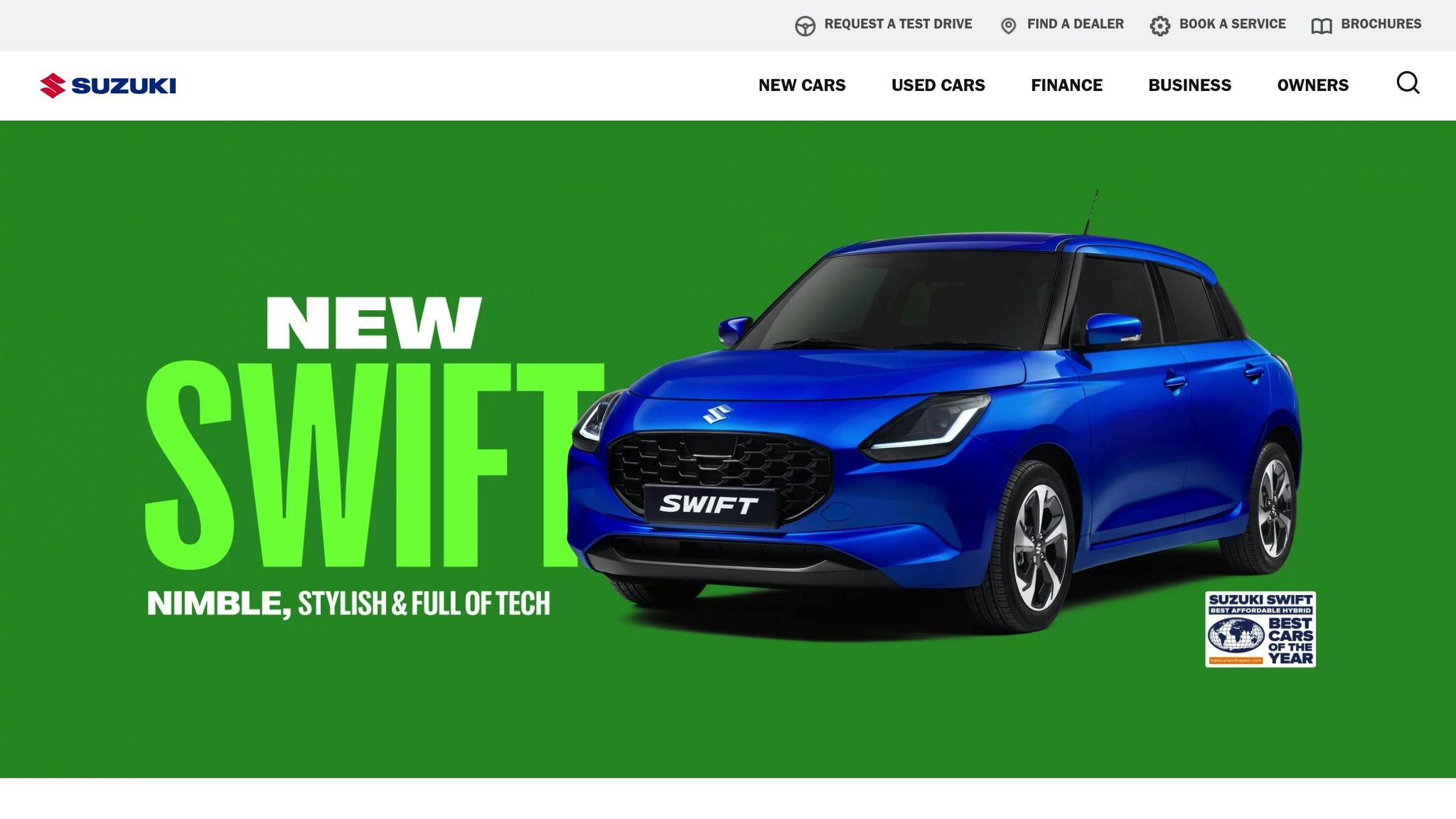
Suzuki has long been known for producing reliable and affordable cars, but as of 2025, a fully electric Suzuki Swift is not yet available. Instead, the current offering is a mild-hybrid version. This distinction is crucial for buyers in the DRC, as it separates Suzuki’s current hybrid technology from its anticipated electric advancements.
Current Suzuki Swift Options

The 2025 Suzuki Swift on the market is equipped with a mild-hybrid system rather than being a fully electric vehicle. This system combines an Integrated Starter Generator (ISG) with a 10Ah lithium-ion battery to support the gasoline engine [57, 58]. While this setup improves fuel efficiency, it still relies on gasoline, meaning it doesn’t deliver the zero-emission benefits of a fully electric car.
These details provide important context for understanding its pricing and market position.
Price (US Dollars)
The base GL model of the 2025 Suzuki Swift starts at approximately $23,490, with the mild-hybrid version priced slightly higher at $24,490 [52, 56]. These figures highlight the price gap between hybrid options and fully electric vehicles.
Suzuki’s Electric Future
Although the current Swift remains a mild-hybrid, Suzuki is actively preparing for an electric future. The company’s first fully electric vehicle, the e Vitara, is set to debut in the United Kingdom. This model, the e Vitara Motion 2WD, features a 49 kWh battery pack and represents Suzuki’s initial step into the electric vehicle market. Positioned at a higher price point than the Swift, the e Vitara signals Suzuki’s dedication to growing its electric lineup.
For buyers in the DRC seeking zero-emission options, Suzuki’s upcoming electric models, like the e Vitara, are worth keeping an eye on.
Price and Feature Comparison Table
Here’s a side-by-side comparison of electric vehicle (EV) specs to help you find the best option for driving conditions in the DRC. As discussed earlier, factors like price, range, and charging efficiency are especially important in this market.
| Model | Price (USD) | Range | Battery Type | Charging Time | Key Benefits for DRC |
|---|---|---|---|---|---|
| BYD Dolphin | $15,000 – $18,000 | 301 miles (484 km) | LFP Lithium Iron Phosphate | 30 min (10-80%) | Heat-resistant battery, compact size for city driving, affordable maintenance |
| Geely Geometry C | $16,500 – $20,000 | 342 miles (550 km) | NCM Lithium-ion | 30 min (30-80%) | Long range for intercity travel, reliable safety features, good ground clearance |
| Leapmotor T03 | $12,000 – $15,000 | 265 miles (426 km) | LFP Lithium Iron Phosphate | 36 min (30-80%) | Lowest-priced model, easy parking in tight spaces, low operating costs |
| Dongfeng EV EX1 | $13,500 – $16,500 | 248 miles (400 km) | LFP Lithium Iron Phosphate | 40 min (20-80%) | Rugged build quality, simple maintenance, good for rough road conditions |
| Suzuki Swift | $24,490 | N/A (Mild Hybrid) | 10Ah Lithium-ion | N/A (Not fully electric) | Widespread service network, fuel efficiency improvement, familiar brand reliability |
This table highlights which model is better suited for urban commutes versus longer trips, making it easier to evaluate your options.
For those on a budget, the Leapmotor T03 is the most affordable EV, starting at just $12,000. Its compact design and low operating costs make it perfect for city driving. Meanwhile, the Geely Geometry C stands out with an impressive 342-mile range, ideal for longer journeys between major cities like Kinshasa and Lubumbashi.
In terms of technology, the BYD Dolphin, Leapmotor T03, and Dongfeng EV EX1 use LFP (Lithium Iron Phosphate) batteries, which are better suited for the DRC’s hot climate compared to traditional lithium-ion batteries. These models also offer a balance of affordability and durability, making them practical choices for the region.
On the other hand, the Suzuki Swift operates as a mild hybrid rather than a fully electric vehicle. While it doesn’t offer zero emissions or the long-term savings of EVs, it provides improved fuel efficiency and the reliability of a well-known brand, which might appeal to buyers who prefer familiar technology.
For DRC buyers, the Leapmotor T03 is an excellent choice for those prioritizing affordability, while the Geely Geometry C is perfect for maximum range. For a well-rounded option, the BYD Dolphin delivers a solid mix of price, range, and climate-appropriate battery technology, making it a versatile pick for most drivers.
Pros and Cons of Electric Cars in the DRC
Electric vehicles (EVs) bring both opportunities and challenges for buyers in the Democratic Republic of Congo (DRC). While they promise economic and environmental advantages, there are significant hurdles buyers must navigate.
| Advantages | Challenges |
|---|---|
| Economic Benefits | Infrastructure Limitations |
| – No fuel costs and lower maintenance expenses | – Limited number of charging stations across the country |
| – Tax exemptions (100% VAT and customs duty relief) | – Frequent power outages due to an unreliable electricity grid |
| – Boosts the mining sector, a key contributor to the economy | – Higher upfront costs compared to traditional vehicles |
| Environmental Impact | Technical Barriers |
| – Cuts greenhouse gas emissions | – Scarcity of skilled EV repair technicians locally |
| – Improves urban air quality | – Dependence on costly imported parts |
| – Aligns with the global shift toward clean energy |
Economic Benefits and Challenges
For many in the DRC, the financial perks of EV ownership are a major draw. The government has introduced incentives like 100% exemptions on VAT and customs duties for fully electric vehicles, reducing initial costs significantly. On top of that, EV owners can save thousands of dollars annually by sidestepping fluctuating fuel prices – a critical factor in a region where gas prices can be unpredictable.
On the flip side, infrastructure remains a pressing issue. The continent needs a $1 billion investment by 2025 to establish a robust EV charging network. The DRC, like many African nations, struggles with an unstable power grid, making reliable charging access a challenge. Additionally, financing costs for EVs in the region are seven times higher than in Western markets, further complicating affordability.
Technical and Environmental Considerations
The environmental benefits of EVs are clear. They reduce greenhouse gas emissions, contribute to cleaner air in urban areas, and support the global push toward renewable energy. However, technical issues present a significant barrier. The lack of local EV manufacturing means buyers rely on expensive imported parts, which can lead to longer repair times and higher costs. Furthermore, the scarcity of local expertise in EV maintenance adds another layer of difficulty for owners.
EV24.africa: A Solution for DRC Buyers

To address these challenges, EV24.africa offers a comprehensive service tailored to the DRC market. From managing imports through the Port of Matadi to handling customs clearance, registration, and tax compliance, the platform simplifies the buying process. With access to over 200 EV models from more than 25 global brands, buyers have a wide range of options to suit their budgets and needs.
"Africa is ready for electric vehicles, and EV24.africa is committed to making this transition smooth and accessible. Our goal is to provide a reliable, transparent, and competitive marketplace for EV buyers across the continent."
- Axel Peyriere, Co-Founder and CEO of AUTO24.africa
With dedicated teams in Kinshasa, Lubumbashi, and Goma, EV24.africa bridges the gap between global EV technology and local market demands. The platform also provides clear guidance on tax exemptions, customs duties, and available incentives, ensuring buyers have the information they need to make informed decisions.
Looking Ahead: Balancing Expectations
For urban drivers in Kinshasa or Lubumbashi with access to reliable home charging setups, EVs can be a practical and cost-effective choice. However, for those traveling to remote areas or dealing with inconsistent electricity, waiting for further development in charging infrastructure might be a wiser option.
There’s also a broader economic angle to consider. The International Energy Agency predicts a sharp rise in demand for minerals like lithium (90% increase by 2040) and nickel and cobalt (60–70% increase). This surge could create economic opportunities in the DRC, potentially funding infrastructure improvements that make EVs more accessible in the long run.
Ultimately, buyers in the DRC must weigh these factors carefully to make the best decision for their circumstances. While the road to widespread EV adoption in the DRC is still being paved, the long-term potential is undeniable.
Conclusion
Five electric vehicles offer a range of options to suit different budgets and performance needs in the DRC. These include the BYD Dolphin, ideal for urban commuters; the Geely Geometry C, known for its extended range; the compact Leapmotor T03, perfect for city driving; the Dongfeng EV EX1, which comes at a more accessible price; and the Suzuki Swift Electric, backed by the reliability of a familiar brand.
These vehicles are paving the way for more sustainable mobility in the region. The DRC government supports this shift by offering tax exemptions, such as waiving VAT and customs duties on fully electric vehicles. Beyond that, electric vehicles eliminate fuel costs and reduce maintenance expenses, providing long-term financial relief. However, challenges persist, particularly with infrastructure in areas outside major cities. That said, urban residents in Kinshasa, Lubumbashi, and Goma are starting to benefit from the growth of charging networks. For these city dwellers, the financial advantages of electric vehicles – especially as fuel prices rise – make them an increasingly attractive option despite current limitations.
To make the transition easier, EV24.africa offers a streamlined purchasing process. With access to over 200 electric vehicle models from more than 25 global brands, they provide dedicated support teams in Kinshasa, Lubumbashi, and Goma to assist buyers every step of the way.
FAQs
What are the main challenges to adopting electric vehicles in the DRC, and how can they be overcome?
The Democratic Republic of Congo (DRC) faces several hurdles in embracing electric vehicles (EVs). Among the most pressing are the lack of charging infrastructure, high initial purchase prices, limited public awareness, and competition from dominant industries like oil and mining. These barriers make EV adoption slower and less feasible for many people.
To overcome these obstacles, the DRC could prioritize developing a dependable charging network, introducing tax breaks to make EVs more affordable, and raising public awareness about the benefits of switching to electric transportation. Supporting local manufacturing efforts and integrating renewable energy solutions could also help reduce costs, promote sustainability, and generate employment opportunities. Addressing these challenges could set the stage for a cleaner, more inclusive transportation system in the DRC.
How do government programs in the DRC make electric vehicles more affordable for buyers?
Government Efforts to Boost Electric Vehicle Adoption in the DRC
In the Democratic Republic of Congo (DRC), the government is taking steps to make electric vehicles (EVs) more accessible to the population. By offering subsidies and backing the development of the local EV industry, these initiatives aim to bring down the initial costs of EV ownership. This approach opens the door for more people to consider EVs as a practical option.
The DRC’s rich reserves of natural resources, particularly cobalt, are also a critical part of the global EV supply chain. By tapping into these resources and encouraging local manufacturing, the government is not only working to cut costs but also promoting cleaner transportation options across the region.
What factors should car buyers in the DRC consider when comparing the overall costs of electric vehicles to traditional gas-powered cars?
When weighing the choice between electric vehicles (EVs) and gas-powered cars, buyers in the DRC should take a close look at the total cost of ownership (TCO) across the vehicle’s lifespan. While EVs often come with a steeper initial price tag, they tend to shine when it comes to ongoing costs. Think lower fuel expenses (electricity instead of gas) and reduced maintenance needs. Plus, government incentives or tax credits might help ease the upfront financial burden.
It’s also important to consider local factors like electricity rates, the availability of charging stations, and the potential savings from cutting back on fuel use. EVs are built with fewer moving parts, which often translates to lower repair bills over time. On top of that, their environmental perks and long-term savings make them an appealing choice for anyone looking for sustainable transportation. By keeping these aspects in mind, buyers can make a decision that aligns with their budget and priorities.


